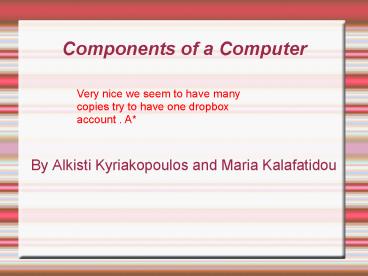Components of a Computer - PowerPoint PPT Presentation
Title:
Components of a Computer
Description:
Title: Components of a Computer Author: Richard N. Jones Description: General introduction of a new product taking customer wishes into account Last modified by – PowerPoint PPT presentation
Number of Views:45
Avg rating:3.0/5.0
Title: Components of a Computer
1
Components of a Computer
- By Alkisti Kyriakopoulos and Maria Kalafatidou
Very nice we seem to have many copies try to have
one dropbox account . A
2
The CPU
- CPU stands for Central Processing Unit.
- Its job is to carry out all the computer program
instructions.
3
Speed
- Instructions per second (IPS) is a measure of a
computer's processor speed. - A typical speed is around 600-700MHz.
- The world record is 8.429GHz by AMD.
4
Peripherals
- Theyre computer devices that arent part of the
essential computer. Peripheral devices can be
external -- such as a mouse, keyboard, printer,
monitor, external Zip drive or scanner - or
internal, such as a CD-ROM drive, CD-R drive or
internal modem. - I/O is short for input/output. The term I/O is
used to describe any program, operation or device
that transfers data to or from a computer and to
or from a peripheral device. Every transfer is an
output from one device and an input into another.
Devices such as keyboards and mice are input-only
devices while devices such as printers are
output-only. A writable CD-ROM is both an input
and an output device.
5
ROM
- ROM stands for Read-Only Memory.
- It is used for storing programs.
6
RAM
- RAM is short for Random-Access Memory.
- RAM is used for storing data.
- We measure its size using bytes.
7
BIOS
- BIOS stands for Basic Input/Output System. The
primary function of the BIOS is to set up the
hardware and load and start a boot loader. - Its the first code run by a PC when powered on.
When the PC starts up, the first job for the BIOS
is to initialize and identify system devices such
as the video display card, keyboard and mouse, har
d disk drive, optical disc drive and
other hardware. The BIOS then locates software
held on a peripheral device (designated as a
'boot device'), such as a hard disk or a CD/DVD,
and loads and executes that software, giving it
control of the PC. This process is known
as booting, or booting up, which is short
for bootstrapping.
8
CMOS
- Complementary metaloxidesemiconductor (CMOS) is
a technology for constructing integrated
circuits. CMOS technology is used in
microprocessors, microcontrollers, static RAM,
and other digital logic circuits. CMOS technology
is also used for several analog circuits such
as image sensors (CMOS sensor), data converters,
and highly integrated transceivers for many types
of communication. - Two important characteristics of CMOS devices are
high noise immunity and low static power
consumption.
9
Clock
- Clock speed (a.k.a. clock rate) is the speed at
which a microprocessor executes instructions.
Every computer contains an internal clock that
regulates the rate at which instructions are
executed and synchronizes all the various
computer components. The CPU requires a fixed
number of clock ticks to execute each
instruction. The faster the clock, the more
instructions the CPU can execute per second. - Clock speeds are expressed in megahertz (MHz) or
gigahertz (GHz).
10
Secondary storage
- The primary storage device is RAM. First the data
will enter into this storage device. In this
storage device the data will be not permanent
when ever we switch off the computer. The data
will be erased so it is called primary storage.
The secondary storage devices are hard disks,
floppy drives, tape drives, etc. In this the data
will be stored permanently. The data or
information will be not lost in this devices. - Non-volatile means that the computer memory can
retain the stored information even when its not
powered.































